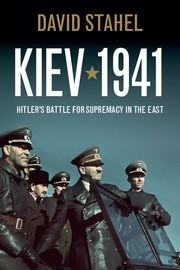Book contents
- Frontmatter
- Contents
- Figures
- Tables
- Maps
- Acknowledgements
- Glossary of terms
- Tables of military ranks and army structures
- Introduction
- 1 The bulldog, the eagle and the bear
- 2 Germany's defeat in the east
- 3 The road to Kiev
- 4 War in the Ukraine
- 5 Ominous horizons
- 6 The battle of Kiev
- 7 Slaughter in the Ukraine
- 8 Visions of victory
- 9 The calm before the storm
- 10 Moscow in the crosshairs
- Conclusion
- Notes
- Bibliography
- Index
4 - War in the Ukraine
Published online by Cambridge University Press: 05 November 2011
- Frontmatter
- Contents
- Figures
- Tables
- Maps
- Acknowledgements
- Glossary of terms
- Tables of military ranks and army structures
- Introduction
- 1 The bulldog, the eagle and the bear
- 2 Germany's defeat in the east
- 3 The road to Kiev
- 4 War in the Ukraine
- 5 Ominous horizons
- 6 The battle of Kiev
- 7 Slaughter in the Ukraine
- 8 Visions of victory
- 9 The calm before the storm
- 10 Moscow in the crosshairs
- Conclusion
- Notes
- Bibliography
- Index
Summary
The absent southern offensive – Rundstedt's intractable overextension
On 28 August Mussolini joined Hitler on a flight to Uman’ in the Ukraine for an inspection of the newly arrived CSIR (Corpo di Sedizione Italiano in Russia; Italian Expeditionary Corps in Russia). The Italian dictator had been Hitler's guest since 25 August, but little of real substance had been decided by their summit. The visit was far more important for its highly symbolic nature. The recent meeting between Churchill and Roosevelt and the subsequent publication of the Atlantic Charter necessitated a spirited show of Axis unity. There was also the current joint action by Soviet and British forces in occupying Iran, which made the entry of Italian troops on the eastern front an opportunity for convenient riposte.
Upon their arrival in Uman’ the dictators were given an outline of military operations in Army Group South, where Italian troops would now be employed. Rundstedt, Kleist and Löhr all gave reports. Hitler and Mussolini then set out to observe a previously arranged march-past by Italian troops. The divergent impressions of this event could not have been more contrasting. According to one witness, Mussolini took the salute and cheers of his troops ‘like Caesar in person’ and on the return journey he made extravagant promises to Hitler that more divisions would be sent to the eastern front ‘and naturally only the best ones’. While Mussolini extolled in the martial glory that he so fervently coveted, German impressions were adversely influenced by the perceived lack of professionalism and motorization within the CSIR. The OKH had initially protested against the deployment of Italian divisions owing to the additional demands they would place on the overstretched railways. Now that the Italian troops had arrived, Keitel, who accompanied Hitler on the visit to Army Group South, described what he saw as a ‘boundless disappointment’. Elaborating further, Keitel wrote, ‘Their officers were far too old and made a sorry sight, and could only have had a bad effect on the value of such dubious auxiliaries. How were half-solders like these supposed to stand up to the Russians’? Hitler expressed a similar sentiment when he remarked to his officers that the Italians could offer very little on the eastern front. Indeed, according to his Luftwaffe adjutant, Hitler claimed they possessed no fighting strength and that their contribution was really only important for the purposes of morale. Even more ominously, the former diplomat Ulrich von Hassell noted in his diary three weeks after Mussolini's visit that there was now ‘great concern about Italy’. Hassell was one of the few men inside Hitler's Germany who saw matters clearly. Informed by a variety of outside sources, Hassell was hostile to the Nazi party and an active figure in the resistance movement. His unclouded perspective allowed him to draw grave, if realistic, conclusions about the future. On 20 September Hassell wrote, ‘Enough information about the Mussolini visit has filtered through to show clearly how vulnerable our situation is, and how every chance for a reasonable peace goes to the devil as soon as the other side sees victory ahead.’
- Type
- Chapter
- Information
- Kiev 1941Hitler's Battle for Supremacy in the East, pp. 135 - 170Publisher: Cambridge University PressPrint publication year: 2011

